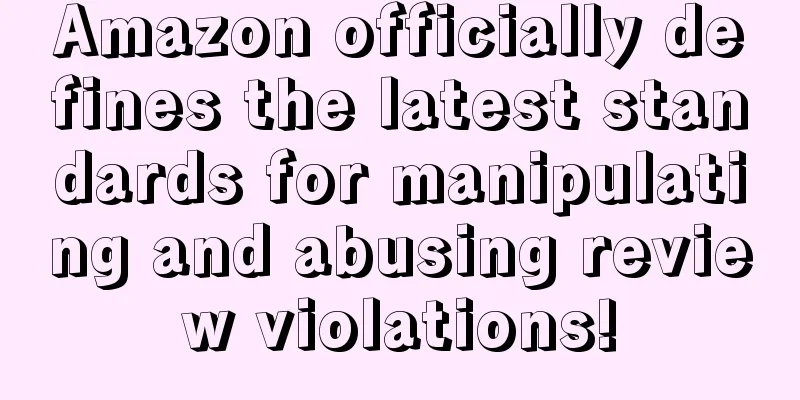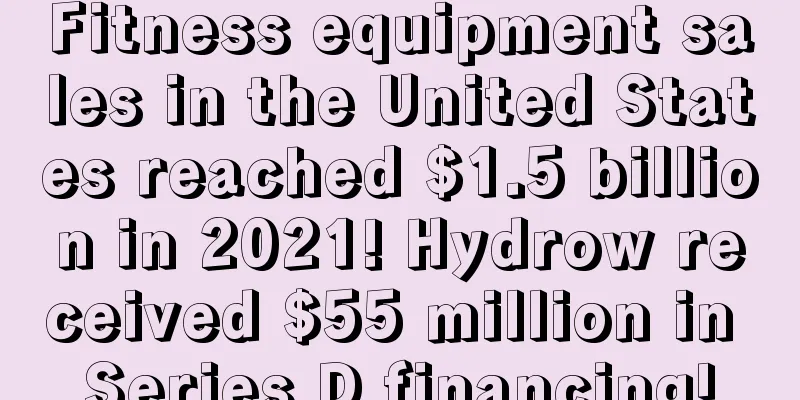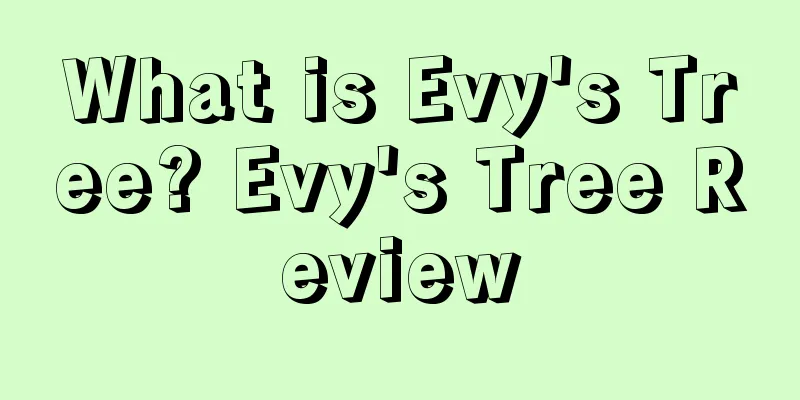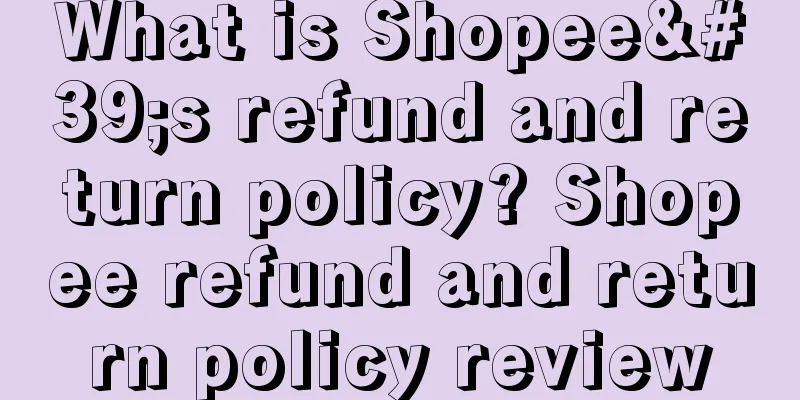Amazon officially defines the latest standards for manipulating and abusing review violations!

|
As we all know, Amazon has very strict control over buyer reviews, and has zero tolerance for sellers who manipulate reviews. In recent years, under Amazon's iron-fisted governance, countless buyers have been kicked out for violating product review policies . Recently, Amazon once again gave detailed official answers and definitions on the manipulation and abuse of reviews, including how to obtain reviews correctly, which methods of obtaining reviews are not advisable, and which illegal review behaviors will be punished. Reviews allowed by AmazonRecently, Amazon has officially defined the abuse of product reviews again. In daily operations, sellers can refer to the following three methods to leave compliant reviews for products. 1. Direct reviews: reviews that can be left without real purchase. Each review costs about 8-15 yuan. *Advantages: fast publishing speed and low cost, which can help novice sellers improve their store search weight, ranking, star rating and conversion rate. *shortcoming: ① Direct reviews have a low retention rate and a short existence time. After a review is approved, it usually takes 1-2 working days for it to be displayed on the product page, and it may only be retained for 3 days to 1 month. It will be deleted immediately after the system makes a judgment. ② The number of direct reviews is limited, and consumers can only submit 5 direct reviews per week. If there are too many direct reviews, it is easy for Amazon to restrict the review, and the listing may also be restricted (including VP reviews). ③ There will be no mark on the comments left by direct reviews. They are usually at the bottom of the listing page, or consumers need to actively filter them to see them. 2. Verified Purchase Only consumers who have actually purchased the product can leave a review. That is, only consumers who have browsed and purchased the product can leave a review. VP reviews will be displayed first and will be marked with "Verified Purchase" or "VP". As shown below: If you need to actively ask buyers to leave reviews, you can go to the Amazon backend order page, open the order that requires a review, click the "Request Review" button in the upper right corner of the page, and ask the buyer for a review. 3. Vine Project The Amazon Vine program is an in-site review feature open to brand sellers. Participating in the Amazon Vine program helps build product awareness, helps slow-selling ASINs and new ASINs that are not highly popular increase sales, and helps buyers make informed purchasing decisions for new products you sell. Compared with ordinary buyers, buyers who become "Vine members" need to be screened by Amazon before they can participate in the Vine program, and merchants can only review the free products after they have passed the application of these members. Generally speaking, these Vine Reviews are more credible and more convincing. Unacceptable product review behavior ① Directly interfere with buyers’ comments Amazon prohibits contacting buyers through the Amazon Buyer-Seller Messaging Service to request or induce them to leave positive reviews for products or to modify or delete negative reviews. ② Providing any form of compensation in exchange for reviews of your own or your competitors’ products (1) Amazon prohibits directly contacting buyers through the Amazon Buyer-Seller Messaging Service to offer buyers compensation (cash back) in exchange for reviews. (2) Amazon prohibits sellers from offering refunds, cash back, repurchase discounts, or gift cards as compensation in exchange for reviews on its website or any social platform (such as WeChat, Facebook, etc.) on their own or by hiring third-party service providers. ③ Create multiple accounts to impersonate buyers and manipulate reviews Amazon prohibits the creation of multiple fake buyer accounts to post false reviews (including good and bad reviews), commonly known as zombie accounts, self-supporting accounts, etc. ④ 04 Arrange for others to comment on your own products or your competitors’ products. Amazon prohibits sellers from arranging family members, friends or employees to post false reviews for their own or competitors' products. ⑤ Soliciting positive reviews or offering incentives in exchange for reviews in product packaging or boxes. Amazon prohibits the inclusion of inserts, flyers, coupons, brochures, gift cards, cash vouchers, or similar items in products or product packaging that solicit positive reviews or offer incentives for posting reviews. ⑥ Log in to the buyer’s account to post a comment. Amazon prohibits sellers from logging into buyers’ accounts through improper means and posting or changing reviews for their own products or competitors’ products through buyers’ accounts, commonly known as “account hacking”. ⑦ Illegal variant. Amazon prohibits sellers from logging into buyers’ accounts through improper means and posting or changing reviews for their own products or competitors’ products through buyers’ accounts, commonly known as “account hacking”. If you need to approach the single cat cross-border seller group for communication or Simply put, if Amazon discovers any attempt to manipulate buyer reviews, it will take immediate action, and sellers may face the following consequences: ASIN is restricted, reviews are removed and no subsequent reviews can be received, products are removed from the shelves and accounts are blocked, funds are withheld, and legal action is taken against the seller, etc. Status of accounts that have been found to have abused commentsRed warnings remind sellers: "Due to one or more serious violations, your account will be suspended. To avoid account suspension, please resolve these violations immediately." The impact of this violation on the account rating is "significant". At the same time, sellers will also find that this type of account suspension warning is different from other types of violations in that the account score is directly cleared to "0", which shows the seriousness of this type of violation. "Fake reviews", "asking for five stars" and "stuffing (review request) cards" are examples of serious violations on Amazon . One serious violation can cause your account health rating score to be reset to zero and your account to be deactivated! Complaints Process GuidanceThere are two ways to appeal: admitting the violation and not admitting the violation. ① Admit violation Questionnaire format: If the seller admits that they have abused product reviews, they will need to complete a questionnaire-style appeal as prompted by the appeal page, providing a detailed description of all methods used to post or obtain prohibited product reviews, a list of illegal reviews and valid review IDs, review links, and the actual operator who chose to abuse product reviews on the account (the seller or a third-party service provider). POA Form: Since each case is different, please refer to the instructions in the performance notification and, if necessary, submit a detailed appeal letter, including the root cause of the problem, the solution and preventive measures. Please provide the following relevant information in the appeal letter: ➤1. Root cause: Details of the violation that abused the product review policy. 🔸Investigate and confirm: whether the violations mentioned in the performance notification exist in your account. 🔸If any, please provide a detailed description of the illegal activities that abuse the product review policy (including specific operation procedures and relevant information). 🔸Also provide screenshots/attachments to prove the above information. ➤Solution: Describe the specific steps and evidence for solving the problem at hand. 🔸Has the illegal behavior been terminated? 🔸Have comments resulting from past violations been dealt with accordingly? 🔸Have the relevant materials of the illegal communication been removed? Including relevant FBA inventory and in-site message templates. ➤Preventive measures: Develop a detailed plan for the root cause and how sellers will eliminate product review manipulation in the future. Note: If you use a third-party service provider, please provide the following information: 🔸 Contact information of the third-party service provider (such as name, email, address, phone number, website, etc.): How the seller found the third-party service provider. 🔸 A detailed description of how the third-party service provider committed the violation: proof of payment, chat records, etc. of cooperation with the third-party service provider, as well as proof of termination of cooperation with the third-party service provider. ② Do not admit to violation If the seller believes that the violation mark was misjudged, the seller should submit an explanation of the following information: 🔸 Provide supporting documents or evidence to prove that your account has not violated Amazon's product review policy. 🔸 The seller claims not to have engaged in abuse or used third-party services. 🔸 Evidence or supporting documentation that the seller’s identity or account information has been stolen. Here I would like to remind everyone that Amazon has already obtained certain evidence before sending a warning email, so if the seller violates the rules, it is best to admit the mistake honestly and do not try to play tricks with Amazon! If you are indeed misjudged, you can submit relevant evidence through the appeal channel provided by the platform to prove your innocence. Additionally, avoid the following pitfalls after receiving a comment abuse notification: 🔸 Directly delete the contact information of third-party service providers, such as WeChat accounts, Facebook groups, etc. Note: If you use a third party, the above information and evidence are necessary materials in the appeal process. If they are not properly preserved, your appeal may not be approved. 🔸 When receiving a phone call from an account status specialist, denying everything, such as "I didn't fake the reviews", "I didn't stuff the cards", "I didn't manipulate the reviews", etc. Finally, Amazon officials rarely misjudge violations of buyer review policies. Appeals of innocence or denials will most likely be considered quibbling and rejected directly. Generally, it is better to admit the mistake directly, apologize, and make corrections later. This approach has a relatively high approval rate. At the same time, do not appeal blindly, otherwise the reviewer will directly reject it and reply that there is insufficient information. |
<<: Crashed! How many of these 10 Amazon crash moments have you experienced?
Recommend
Etsy releases the latest consumer trends for home improvement in 2022! Popular product recommendations
It is learned that Etsy recently released the late...
FBA shipments lost multiple times and claims failed? That’s because your approach is wrong!
Maomao often sees in the seller group that many se...
Target's third-party market is growing slowly! Far behind Amazon and Walmart!
<span data-shimo-docs="[[20,"获悉,根据Marketpl...
Free service? Plus a tax ID! It’s finally Amazon’s turn to make the most of it!
Sellers all joke that they are the leeks raised by...
The first round of “Black Friday” battle report: Some European sellers’ sales doubled, while the growth of orders on the US site showed a slight downward trend?
Storm Baby 2 Anonymous user Amazon's Black Fri...
What is Ireview Home? Ireview Home Review
Ireview Home is a discount website that is control...
How can a beginner do cross-border e-commerce? Eight core points will help you win the market!
To start cross-border e-commerce, you must go thro...
Amazon's Counterattack
Talk less and do more. Every step forward brings ...
What is MyDeal.com.au? MyDeal.com.au Review
MyDeal.com.au is an Australian online marketplace ...
The demand for toys in the US market will slow down in 2023, but these three categories will grow against the trend
It is learned that recently, market research compa...
What is Orange Wind Project? Orange Wind Project Review
On May 26, 2018, Alibaba Global AliExpress launche...
Brand removals are frequent! New trademark protection cases may affect 3C category sellers
“The stronger the wind, the more expensive the fis...
Big seller sharing: Case report on changing key sensitive information of Amazon store
I deal with sellers who encounter various problems...
Overview of the development of the global e-commerce market in 2021! Which markets are worth entering?
In order to help sellers have a better understandi...
Uncovering the secrets of Amazon advertising: understanding the logic and achieving twice the result with half the effort
Amazon offers sellers a variety of advertising for...









